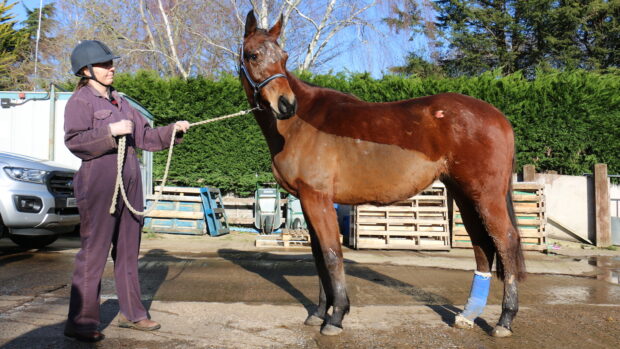It’s dawn as we drive up to the market at 4.30am. There are long queues of all kinds of vehicles waiting to get in — tractors towing tarpaulin-covered trailers, larger lorries, minibus-sized vans, horse-drawn trailers. Most of the lorries are axyl heavy and I wonder how many horses are crammed inside.
Inside the market, three meat wagons (pictured above right) are waiting to take horses on their journey south. Suddenly, it hits hard what I’m doing.
As the horses are unloaded, I’m surprised by how clean and unscathed they are — we see a few wounds, many poor feet and bad shoeing (it’s DIY here, people can’t afford to pay for a farrier). One that can’t put its hind leg down and World Horse Welfare’s director of campaigns, Jo White, thinks it has a fracture.
But, mostly, I’m shocked at the sheer size of them — these horses are really obese. They’re mainly mares and stallions, plus some youngsters.
A clean-looking Italian man with designer glasses is making the deals and farmers cluster around him. It’s all men here, and our interpreter boldly listens to their bartering. Surprisingly, the horses are selling for between 2,000-5,000 (about £500-£1,200) Polish zlotych.
About 28,000 horses are exported from Poland each year — and the ones sold here are either old working horses or youngsters raised specifically for meat.
It’s all over by 8am, and, after watching the loaded meat wagons drive away, we visit a couple of farms with horses for sale.
One old woman farmer has a mare tethered in a small barn. The horse has drastically overgrown front feet — they haven’t been cut in a year.
I ask how long she’s been standing there: “a couple of years” comes the reply. I feel sick.
We then visit a farm where the owner sits on the local horse board. He has two very fat, in-foal mares tethered and munching away at hay, two youngsters in a box together, and two stallions. He’s proud of them, but although they’re well cared for, they’re all startlingly and grotesquely fat.
At the next farm, it’s the same story: three youngsters tethered in a barn and a mare and foal loose in one end. When I look through the slats of her door, she bares her teeth and charges at me.
The last place we visit stinks. Ammonia levels in the dark barn are high and there are half a dozen youngsters ranging from five to eight months, tethered to troughs. In another barn is a mare with thick discharge coming from her nostrils. She has a foal at foot, and they’re both fetlock-deep in foul, wet manure and have swollen hind legs.
I realise why all the horses at the market are so fat and unscathed —they’re tied up their whole lives, and fed endless hay and grain.
They have no muscle at all. Jo tells me that travelling for 24 hours (the current legal EU limit before the horses need to be rested off the lorry) is the same as walking for 24 hours — these animals have never done any exercise.
Our Polish contact explains later that the situation is improving, and many welfare problems are born of ignorance and economics.
These farmers operate just to make ends meet — they don’t dream of making a profit. Simply raising one extra horse could put food on their plate.
We drive on four hours to the Poland/Czech Republic border for supper and to sleep.
Read the second part of Abigail’s daily blog on HorseandHound.co.uk tomorrow (Friday 1 August)



